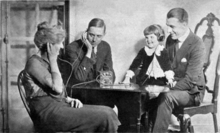Pianos everywhere
At the beginning of the 20th Century, pianos were mass-produced, and most people would have had access to a piano if they wanted, if not necessarily at home, then there would be a piano at a neighbour’s, or at church, in neighbourhood bars and community halls, though perhaps of variable quality.
James P. Johnson (whom we have met in passing already) said “In the years before World War One, there was a piano in almost every home, colored or white. [...]Most people who had pianos couldn’t play them, so a piano player was important socially”. (quoted in Shipton, A, p124).
Eubie Blake
This was precisely the environment Eubie Blake came up through; he initially had no piano at home, but his parents were so proud of his performances on neighbourhood pianos, that they eventually made the sacrifices necessary to buy one in instalments.
Born in 1883 in Baltimore, Maryland, Blake was an essential link between ragtime and stride. Alyn Shipton writes: “When I met him and heard him perform in 1976, he was still an impressive pianist, with a genuine sense of jazz timing in his solo breaks and right-hand figures, but who never quite seemed to have loosened his left hand from the stiff beat of 1880s ragtime”. (Shipton, p125).
Initially called Sounds of Africa when written in 1899, this tune was renamed Charleston Rag in 1919 to cash in on the popularity of the dance.
Boogie Woogie
Listen to the descending figure in the bass of the first theme. It’s a boogie-woogie-like device, although the theme is not a 12-bar blues, but one of a number of raggy themes that make up the piece. There are frequent changes of key, and in the other themes the left hand returns to a bass-note and chord style accompaniment.
James Lincoln Collier points out that Eubie Blake and the proto-jazz pianists from the Northeast were not steeped in the blues, as the New Orleans horn players were: “[...] though they had some contact with the black folk tradition through their churches and the working people who were emigrating from the South, they had little experience with the rural music on which the blues was built”. (JLC, 1978, p194).
Atlantic City
Indeed, that early proto-jazz piano style flourished in Atlantic City, New Jersey, which was experiencing a boom as a popular playground in the first decade of the Twentieth Century, and Blake and others flocked there for employment.
Amongst those finding work there in the years before World War I were James P Johnson and Willie “the Lion” Smith. Alyn Shipton quotes both these players as saying they learned boogie-woogie walking bass in Atlantic City from Southern pianists.
The Harlem style
If, as Ted Gioia suggests, “the piano was to Harlem what brass bands had been to New Orleans” (Gioia, p95), then in some ways Atlantic City was the New Orleans of jazz piano: it was the early melting pot of music where the stride players honed their styles. And just as the New Orleans brass players had made their way to Chicago, so the stride players brought what they’d learned in Atlantic City back to Harlem.
James P. Johnson
James Price Johnson, born in New Brunwick, New Jersey in 1894, is traditionally cited as the “father of stride piano”. In his rag-inflected style you can hear the material - church music, dances, rags, blues, and reels - that brought him work. Johnson was, however, proud of his classical training, under Bruto Giannini, and it is this conflict between highbrow artistic merit and work that pays the bills that Ted Gioia draws attention to when he says that piano music in Harlem was a “battleground between these two visions of black artistic achievement” (p95).
Perhaps Johnson’s most famous composition is Carolina Shout, which became something of a test piece for Harlem Stride players:
Eubie Blake and James P. Johnson on CD.
For Blake, Morton and Cook recommend Memories of You on the Shout Factory label.
And for Johnson, they recommend Carolina Shout on the Biograph label.








